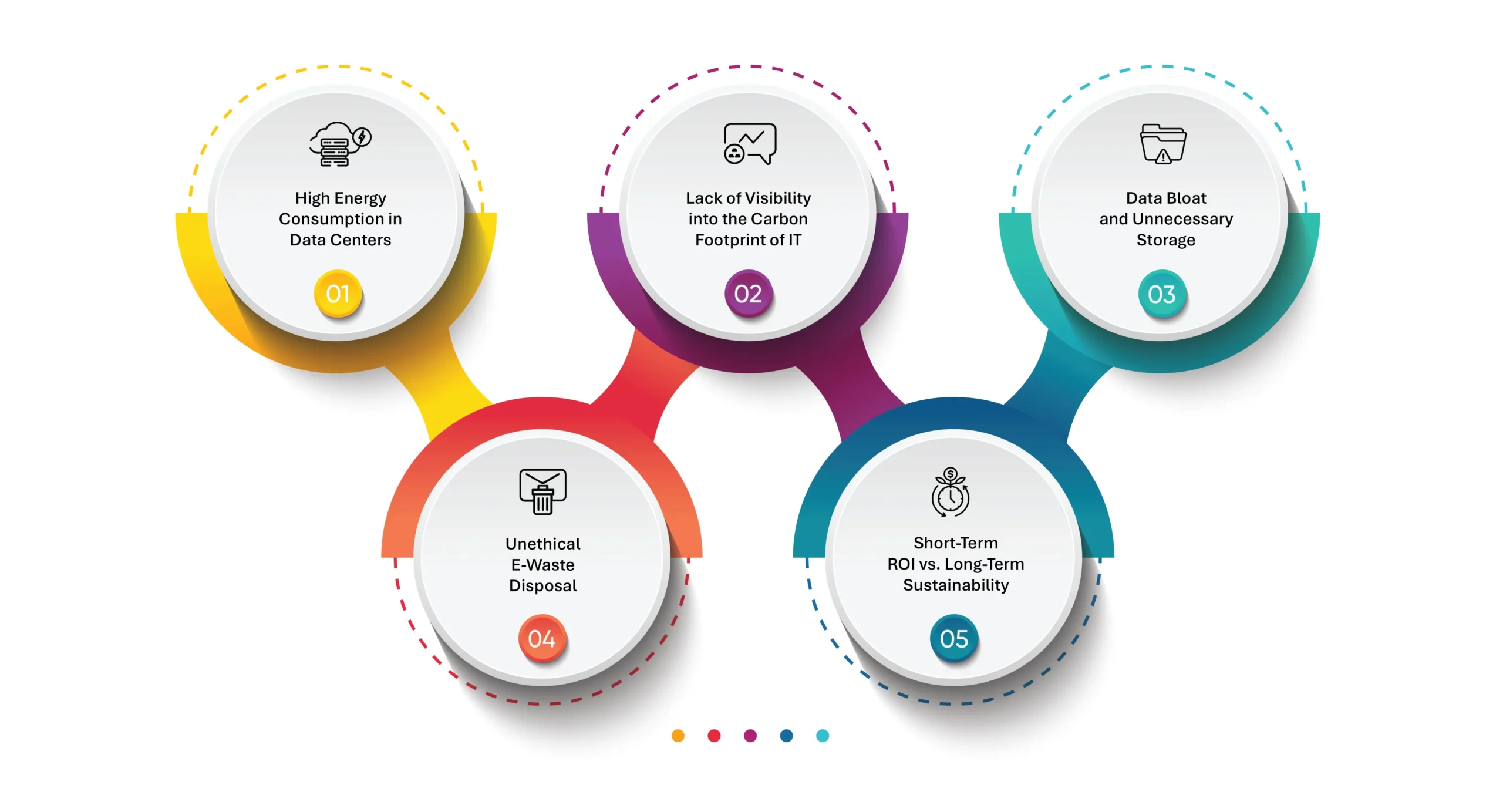What is Green IT?
Green IT, or Green Information Technology, refers to the environmentally responsible use of technology throughout its lifecycle—from design and manufacturing to usage and disposal. It encompasses practices that reduce energy consumption, minimize electronic waste, and lower the carbon footprint of IT operations while aligning with broader Environmental, Social, and Governance (ESG) goals.
Today, Green IT is not just about efficiency—it’s about accountability, resilience, and rethinking the relationship between technology and sustainability.
Sustainable by Design: Rethinking Green IT in the Age of ESG, AI, and Digital Infrastructure
Green IT has evolved from an operational choice to a strategic necessity. As enterprises race to modernize with AI, cloud, and edge infrastructure, the carbon footprint of digital operations is under global scrutiny. Boards, regulators, and customers are no longer just asking “Are you secure?”—they’re asking “Are you sustainable?”
In today’s AI-driven world, compute-intensive workloads consume vast energy resources, from training large language models to running real-time analytics. Simultaneously, unstructured data volumes are exploding, leading to redundant storage, excessive power use, and rising e-waste. Green IT addresses these issues head-on by embedding sustainability into IT architecture—from carbon-aware data center operations and energy-optimized cloud strategies to ethical device lifecycle management and AI workload tuning.
The shift is no longer about reducing impact after the fact. It’s about designing infrastructure, applications, and data flows that are intelligent, efficient, and climate-conscious from the start. For CIOs, CDOs, and CTOs, Green IT is now a lever of long-term resilience, regulatory alignment, and reputational strength. In a world where ESG performance increasingly influences investment and market leadership, digital sustainability isn’t a side project—it’s a growth strategy.
Key Challenges in Achieving Green IT – And What to Do

High Energy Consumption in Data Centers
Many enterprises run legacy systems that lack energy efficiency or scale inefficiently under modern workloads.
What to do:
Adopt liquid cooling, server virtualization, and dynamic power management, and shift to renewable-powered, energy-efficient data centers.
Lack of Visibility into the Carbon Footprint of IT
Most organizations lack real-time insights into how their digital infrastructure impacts sustainability goals.
What to do:
Implement carbon-aware observability tools that track power usage effectiveness (PUE), emissions per workload, and data storage impact across environments.
Data Bloat and Unnecessary Storage
Unstructured and redundant data stored indefinitely leads to energy waste and storage inefficiencies.
What to do:
Enable intelligent data lifecycle management (e.g., automated archiving, deduplication, and deletion) to optimize storage and reduce digital waste.
Unethical E-Waste Disposal
Improper disposal of end-of-life hardware leads to environmental pollution and data security risks.
What to do:
Establish vendor-certified e-waste recycling programs and ensure secure data wiping and asset decommissioning protocols.
Short-Term ROI vs. Long-Term Sustainability
Sustainability investments often lose priority due to perceived low immediate ROI.
What to do:
Frame Green IT as a dual benefit—cost-saving (via energy optimization) and compliance with ESG mandates—while aligning with future-proof innovation strategies.
Where Green IT Delivers Real-World Impact
Carbon-Aware Cloud Strategies
Enterprises are increasingly optimizing cloud workload placement based on carbon intensity. Green IT enables the selection of data centers powered by renewables and provides real-time visibility into emissions metrics, turning cloud migrations into sustainability accelerators.
Sustainable AI and Compute Optimization
Training large AI models and running high-performance computing (HPC) workloads consumes significant energy. With Green IT, organizations can implement energy-efficient scheduling, pause idle compute cycles, and prioritize low-impact processing, reducing both costs and carbon.
Smart Data Lifecycle Management
Uncontrolled data growth strains infrastructure and drives energy waste. Green IT supports automated ROT (redundant, obsolete, trivial) data cleanup, intelligent tiering, and archiving—shrinking the data footprint while maintaining compliance.
Eco-Responsible Device Lifecycle Programs
From procurement to disposal, hardware contributes to e-waste and emissions. Green IT helps establish responsible asset management programs—prioritizing energy-efficient devices, secure reuse, and certified recycling practices.
Sustainable DevSecOps Pipelines
Forward-looking IT teams are embedding sustainability into the software delivery process—tracking build energy usage, reducing compute redundancy in testing environments, and ensuring apps are optimized for leaner resource consumption from day one.
Energy-Aware Observability and Reporting
Green IT tools provide dashboards and alerts that monitor power usage effectiveness (PUE), emissions per workload, and sustainability KPIs—giving CIOs, ESG officers, and infrastructure leads the data they need to act decisively.
Green IT isn’t just about saving power—it’s about powering a more responsible digital future. As enterprises build AI, scale infrastructure, and drive innovation, the need to embed sustainability into every layer of technology becomes a strategic mandate. Green IT transforms IT from a silent contributor to carbon emissions into a key driver of corporate accountability, operational efficiency, and global impact.
Getting Started with Data Dynamics:
- Learn about Unstructured Data Management
- Schedule a demo with our team
- Read the latest blog: Sovereign AI and the Future of Nations: Why Data, Infrastructure, and Intelligence Must Align






